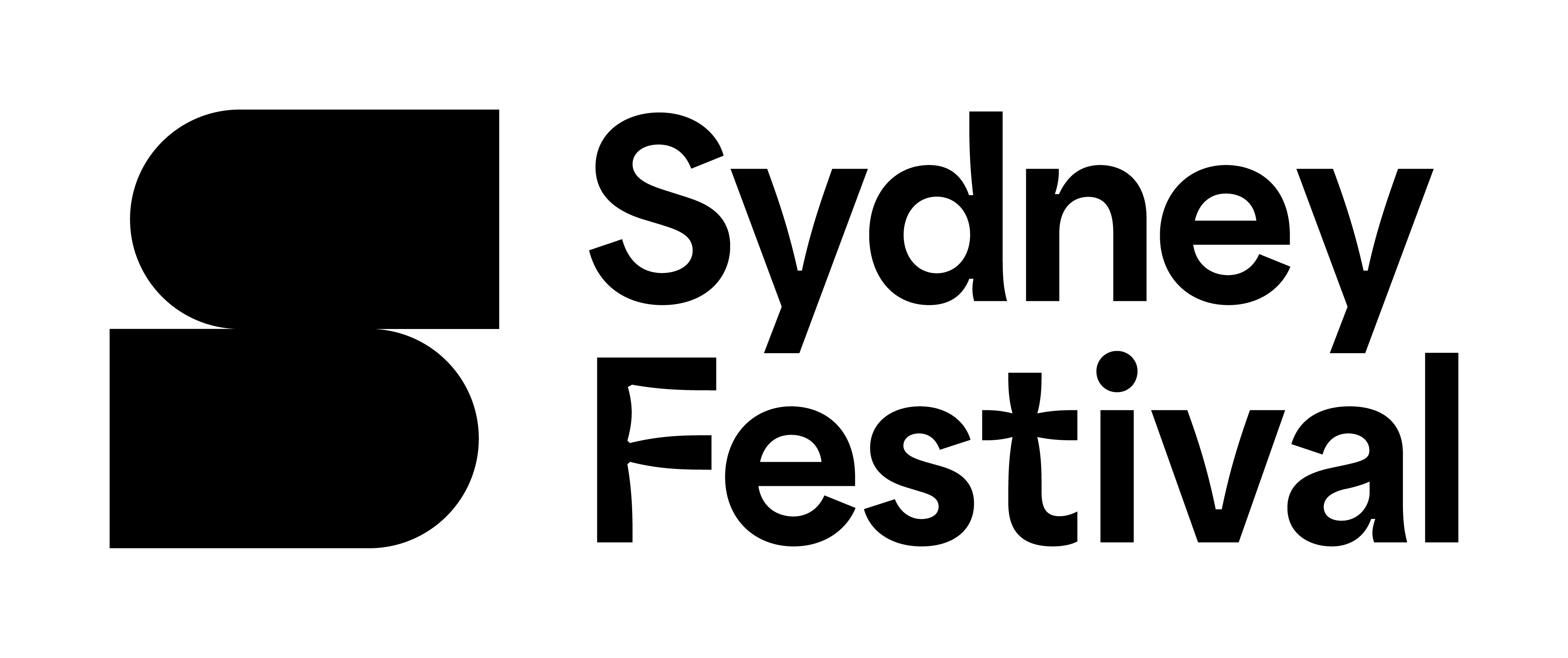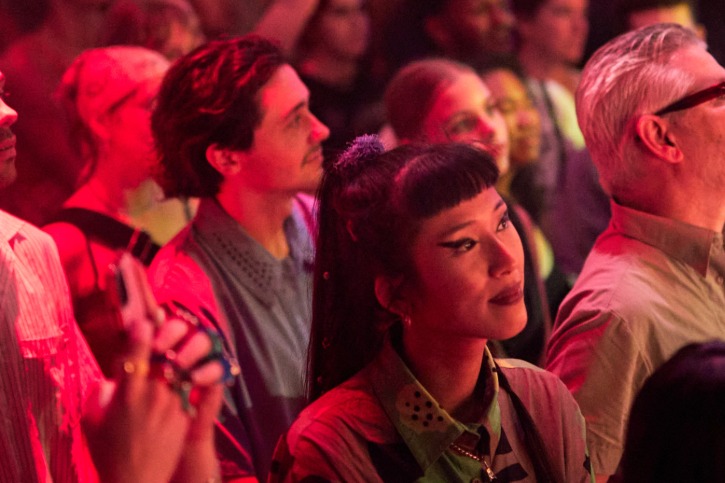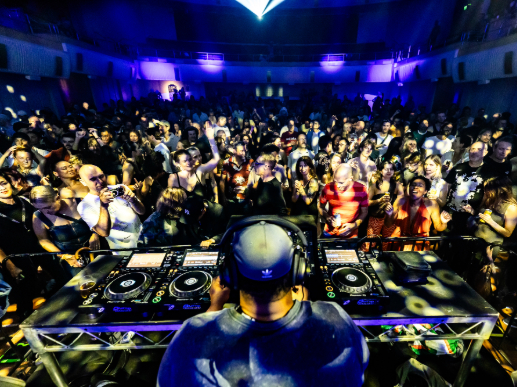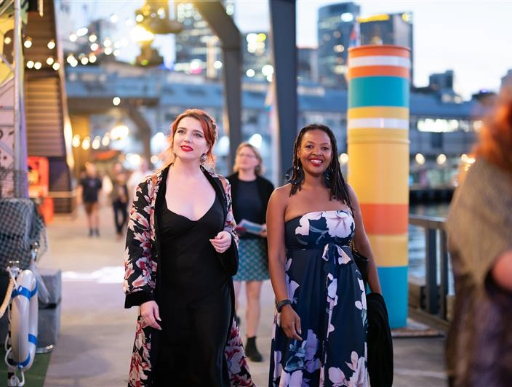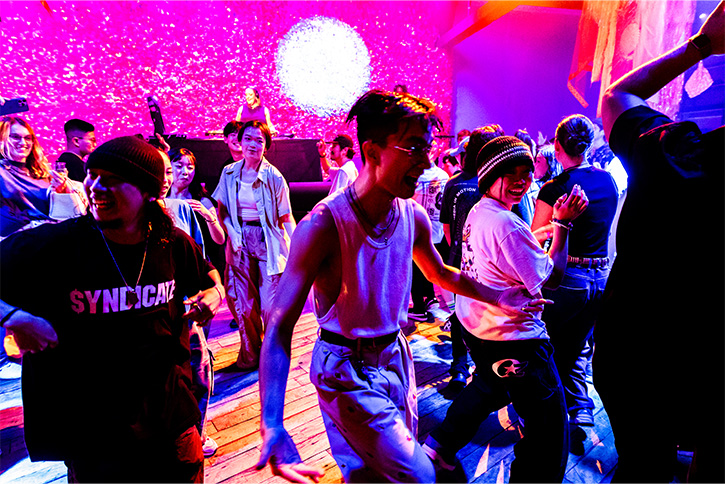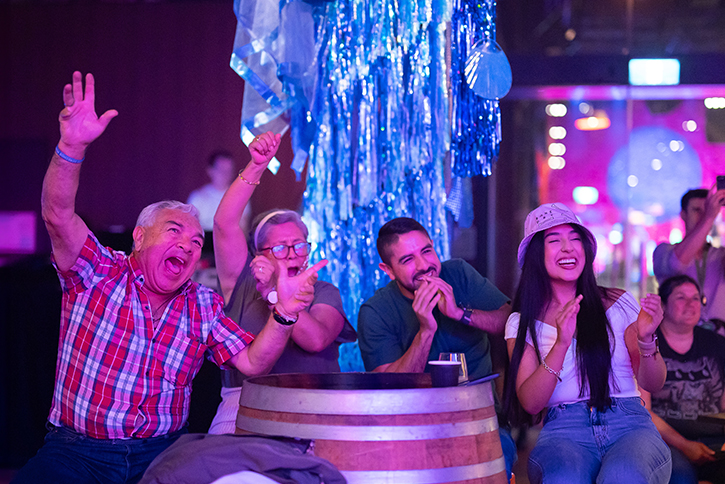>kris image<
A few weeks ago, I caught up with two of Australia’s leading touring artists, Amrita Hepi and S Shaktidaran. I wanted to talk to them about what they see as the future of festival-making, and what they are looking for from their festivals here at home. As I develop my vision for Sydney Festival over these next four years, these are vital conversations to have. I’m excited and challenged by what they put forward.
Shakthi offers reflections on being commissioned by major festivals and the tensions at play between making work of an international scale while deeply involving the community it comes from.
Amrita, hot off a seriously successful season at France’s esteemed Avignon Festival, reflects on global trends, the magic of meeting a festival audience, and provides a dynamite list of things to adopt right now.
S. Shakthidharan
>shakti image<
KRIS: Let’s dive in Shakthi! Your work, Counting and Cracking, had its world premiere at Sydney Festival and went on to some of the world’s greatest theatre stages and festivals. You made the work over a long period of time, in a process deeply rooted in community story. Was there a tension between the making model and the presentation model? What did you learn about the potential of festivals to support the kind of work you make?
SHAKTHI: Wow. Ok. Let’s go. [Pause]
There was a massive tension between the power that art has to unearth from community the complexities of their lived experience (and to do it in a way that feels respectful and safe), and the ability to give that back to them with a complexity that you can never summon in real life. It helped that I was from that community. But that’s not what the mainstage and festival processes are – at least not in Australia. Those processes are caught up in the logistical work of presenting art – and that’s time and location based, not slow and iterative like the community process.
So massive tension, but I went in with eyes wide open. With Wesely Enoch (Sydney Festival Director 2017–2021) and Eamon Flack (Co-Director/Belvoir Artistic Director) we went in saying we wanted the community process to be front and centre – and they were both willing to do that.
I’d learned enough by then: that the big mistake artists make is to worry about the parts of their practice that don’t fit into the festival machine, but that’s counterproductive. It’s going to come back to you as the creator, in moments of high tension, usually with lots of money is at stake and at the time in the process when you don’t need it. You have to be “annoying” off the top, but this is what makes the best art. Any festival director worth their salt will hear that and want to do that with you.
What was really hard at that time, and still is hard now, is that there are so few people who work at the intersection of these two worlds – who understand how to talk to other humans in the world without “art speak”, and how to make them feel like they want to come into an artistic experience when normally that’s not part of their life. You have to know how to do all that, [with] everyday people, and also lawyers and doctors. Artists don’t like to acknowledge this, but they have their own lingo.
I now know that I was lonely in it, in the process. I was and am proud to be at the intersection of those places of professionalism and community. I’d go talk to community or festival people – say I would come talk to an institutional team – it would be me on my own, representing the work and my community: and I’d be talking to 14 people in the institution: creative, technical, marketing etc.
For the future, I’d love for festivals to understand communities better and in deeper ways – so they understand how to work together more holistically. I think of my role still as educational.
"I’d love for festivals to understand communities better and in deeper ways – so they understand how to work together more holistically."
KRIS: Festivals can be incredible launchpads, but they also come with limitations: time, budget, context. What has your relationship with festivals taught you about vision, compromise and care?
SHAKTHI: [It’s taught me] what I absolutely f**king love about festivals. At their best they should be developing and presenting work that is impossible to be anywhere else. That's been integral to my practice and allowed it to have legitimacy and respect. The work itself reaches audiences when it’s good and has context.
In terms of minority community politics, it’s important to talk about the legitimacy that festivals confer. For too long there’s been a subliminal approach in Australia to work that’s not from the UK or North America. Work outside the Anglosphere is ‘supported’ but not seen as central or legitimate.
I think a festival has the potential to back other stories. Counting & Cracking was a big scale work that Wesley backed. Like anyone who’s slightly oppressed, you relish saying, “I don’t care about legitimacy.” There’s comfort there. But when I saw what happened to Counting & Cracking for our audience at Sydney Festival - it actually matters - it matters to take something that’s otherwise ‘radical’ or ‘marginal’ to give it that profile - it says to that community you’re as important as everyone in this city and it says to that art form that your power needs to be unleashed on the city.
"A festival can change the conditions, and be the tool to make the impossible possible."
It was a radical act of belonging for my community. Lots of minority communities have an assumed understanding that we can only be ourselves in private. When a festival is done right, a festival can bring out the complexity of that community and show it to everyone. And that’s the only belonging – to be your full self in public. The arts give an opportunity to have a full public embrace of belonging. A theatre can’t do it on its own – I realised it at Sydney Festival – we made a work inextricably linked to the identity and power of the city.
It’s like we have been talking about, Kris, with my new work Karna. A festival can change the conditions, and be the tool to make the impossible possible.
So Kris, on your side of the fence, you just want to give everyone a shot. So I’m curious as to how you deal with that? You want to find space to give full glory to things, and that’s what makes it hard to spread the love to everyone and not diminish things. How do you reconcile things?
>counting cracking image<
KRIS: It’s a collection of strands. On the people side, I think first I fall in love with an artist. Their inquiry or their mission. An image they’ve put in my head that I can’t stop daydreaming about. And it becomes the thing I know we need to do. I have a weakness for artists who are ferocious divas on stage, and thoughtful, poetic introverts off stage.
And then there’s place. I’m new to Sydney, and that means my process is about seeing what’s here and what’s not here. Amassing and soaking in all these codes of the city and its history – and Sydney Festival’s massive 50 year history – all to come up with a vision for where we need to go next.
Part of that is playing with the festival’s DNA to repurpose things, to continue traditions but also rupture them. To do it in a way that can speak to this city (and Sydney is made up of so many cities) is an exciting puzzle. For example, I’m enjoying wrestling with the notion that someone told me when I got this job that you “can’t get too deep in Sydney or at Sydney Festival.” I don’t buy it. I’ve seen audiences here be incredibly curious and savvy and enjoy the challenge of complex, big stories, and artists who can express the feelings of a whole generation.
As a festival maker, the thing that I’ve been working on, wherever I’ve been, has involved both those practices: dedicating myself to an artist, getting obsessed about what obsesses them, and doing everything I can to align resources, partners and possibilities to make their obsession happen. And having a relationship with a city that creates new memories for civic spaces, that backs projects that are about transformation of an idea, or rupturing a status quo, or giving people a new way of experiencing their city.
It’s a beguiling and wonderful thing to have four years to work on this project here in Sydney, drawing on the expertise of a terrific team to find ways that the Festival can transform the city.
"Dedicating myself to an artist, getting obsessed about what obsesses them, and doing everything I can to align resources, partners and possibilities to make their obsession happen."
KRIS: What do you wish Australian Festivals did more of, and what do you wish they’d drop immediately?
SHAKTHI: Do you want me to say this on the public record? I think Australia as a country still has a poor understanding of itself as part of Asia. The reason we have a problem is we have a cultural block that we’re part of Asia. I wish that this was better understood by those who lead in culture. I wish we’d drop this obsession with spending most of our money on the Anglosphere. Finding ways to celebrate both our Asian neighbours and taking a role as a proudly Asian country.
The exceptional work from the Anglosphere reveals a subliminal bias towards an Anglo way of looking and feeling about the world. Too often the discussion is left within race or geography. What it’s absolutely about are so many different ways of understanding the way to be human – we’re limiting ourselves unless we look at more. We have enormous strides to go there.
The second thing I’d add is time-based. We’re facing a rupturing of our relationship with this planet, and facing a crisis where we’re dooming future generations to not be able to live on this planet. Festivals need to respond to that with a kind of realistic hope. There’s a great potential joy that can come out of crisis. What are the different ways we can be in this world to be here for 10s and thousands of years? This is partly an artist's responsibility. We’ve got to move beyond “it’s climate change and we’re in trouble” to “we are living in a changed world already. What’s our responsibility to change and unlock these possibilities?”
KRIS: What’s your dream for the future of festivals, in terms of how they are imagined, resourced and lead?
SHAKTI: It’s not a small question, Kris. I have a boring answer that if done well would unlock such radical change – it’s an operational change. The engine room of the festival process seems to be only about driving forward to the current year. For the artist, that means what you are going to pitch, and you spend lots of energy and time on that. Then there’s a bunch of waiting, and a few months before the festival you find out if you’re in the festival or not. If you’re in, then it’s all systems go – you do the show and then the race starts again. This is a very capitalist system. The economics drive everything.
I’d love festivals of the future to understand how a deeper, slower and more multi-year process would change the kind of art we make and who gets to make it. Everything from the kinds of artists, to equity, to the climate stuff – it all needs multi-year visions and processes. Change means processes that can go month-by-month, to get out of the year-by-year race to the finish line and bed ourselves into a more iterative, gently cyclic relationship. We need that for everyone to come up with different answers to the challenges we face.
"I’d love festivals of the future to understand how a deeper, slower and more multi-year process would change the kind of art we make."
KRIS: What’s a festival that inspires you and why?
SHAKTI: Back in the day in Sri Lanka, ceremony and festival were critical and ongoing parts of community life. Both with Sinhalese and Tamil communities, there were incredible traditions where all the parts of community came together: thousands of people who feast and tell stories. Festival-going is integral to how people live and breathe. I’d love for us to start taking the first steps towards imagining ourselves like that.
S. Shakthidharan is a Western Sydney storyteller with Sri Lankan heritage and Tamil ancestry. He’s a writer, director and producer of theatre and film, and a composer of original music. His debut play, Counting and Cracking, was voted ‘the best Australian play of the 21st century’ in an ArtsHub poll, was called ‘one of the great Australian plays’ by The Guardian, and was a New York Times Critic’s Pick. The script won the Victorian Prize for Literature in the 2020 Victorian Premier’s Literary Awards and the Nick Enright Prize for Playwriting in the 2020 NSW Premier’s Literary Awards. His latest play, The Wrong Gods, premiered in 2025. His memoir, Gather Up Your World In One Long Breath was published by Powerhouse Publishing in 2025. You can hear Shakthi on his book tour throughout Australia in October in Adelaide, Katoomba, Melbourne and Sydney, and in Indonesia at the Ubud Writer’s Festival in November 2025.
Amrita Hepi
> Amrita pic<
KRIS: Amrita, you’ve just taken your work Rinse to what looked like an absolute smash at Festival D’Avignon. It must have been such a high! What are your reflections coming off a season at this most renowned festival stage?
AMRITA: It was such a high! It also felt really special to bring Rinse to Avignon in particular – this huge apex of a festival. Rinse premiered in 2022, and since then I haven’t toured it in Australia but have been touring overseas a lot, and there’s a sense of pride mixed with sadness in this fact.
I have such respect for Magda and Tiago (Magda Bizarro is Co-Director, Artistic Programme and Tiago Rodrigues is Artistic Director of Avignon Festival), their programming, and how they work. And to be in a festival and place – both with a long history – creates another dimension to its importance.
There is also the dynamic with the audience which is shaped by history and histrionics, but also by a deep sense of ownership by audiences, for better or for worse (to boo or to bravo), whereby they will absolutely let you know what they think or feel. They are incredibly present, which the Murri/Australian in me found thrilling. It raised the stakes, and my focus.
I have performed throughout Europe in Brussels, Germany, France, Norway and England, but not with a solo, and never with text-based work. The festival itself feels like a satellite or pilgrimage to performance. Every single programmer I know will swear down that they cannot bear Avignon (“no more than four days – it's just so intense”), but as an artist being there for the first time and being with other artists that I have long loved and admired (and maybe because my work was one of the 20% that was not a premiere), I adored it.
I used to contrast contemporary performance to pop music or cult cinema in thinking there really is no ‘star status’ in it, only community icons, and that's why I like it! But being there challenged that idea. Also, it felt as though dance was really at the heart of this year's festival.
My reflections on this season at first come back to the snare of comparison. I do not think the grass is necessarily greener anywhere – stay a while and watch how grass grows, or is maintained. My reflections, or comparisons, are that I sometimes wish that the culture of cringe (which is really shame or misplaced pride, or false humility) and scarcity that feels specifically Australian would dilute itself.
I do not see art as an extravagance. And while there has always been a conversation surrounding class and theatre in particular, it was nice to be at Avignon and be reminded of the broad spectrum of audiences and artists that are making work, and that are playing on these big stages – [whether] they are from Kabul or Palestine or a tiny town in Portugal.
I think the ownership that audiences feel entitled to in Avignon creates stakes for any performer or programmer, but that is the part that I feel enriched by. That in my very big, and small, time touring in France that people will fight for things, or have an obsession or fandom with theatre not as artists or programmers but as punters. Meeting accountants or farmers that come to the festival every year. I think Australian performance or audiences are sometimes marred by a sense of scarcity, which I understand to an extent, but it feels misdirected. It's the old catch-cry of “tax payers dollars”, or the apathy of thinking that if the premiere is not perfect after a two-week development that something has been “wasted”. That people “wasted their time” watching (it's like what were you actually going do on a Friday at 6pm? Do your tax? Get pissed at the pub?). Whereas over there, the level of commitment, conversation and appreciation for craft was immense. I loved that Isabelle Huppert was there in her cap watching all the shows, and Sophie Calle. That there is this deep love of the forms of performance; it's almost patriotic in its devotion.
I met Magda (Co-Director, Artistic Programme at Avignon) at a hotel breakfast bar in Montreal whilst doing a season of Rinse. She introduced herself and asked politely if she could give me some feedback. She said I should stay on the stage longer so people have the opportunity to give me a proper round of applause. She then said something to the effect of: you are up there performing, and we are with you, and then if you leave too soon when we are applauding you do not let us have our turn, to show you that we were there with you. I then asked if she was European and we both laughed.
So in short, my reflections are also a reminder that I am big and small and connected to this world of loving, booing, discussing and discoursing of performance and I sometimes forget that I am – which is necessary for making at times, but it’s also important for me to be reminded of the veracity of the audience’s perspective.
Also 4.5/5 stars for the Avignon Festival’s artist bar, set in an old pool that is open until 2.30AM (half star lost because of lack of affordable snacks, which might have slowed my rosé consumption on closing night but also is potentially strategic).
KRIS: Are festivals a space you enjoy working in? What do they offer that’s unique, and where do they fall short for you as an artist?
AMRITA: My definition of a festival is this: it is not solely a season of works (even though it is), it involves many different genres of making – even if it is centred around one form, and there is a hub or heart to it. Whether that be a vineyard, a beach, a Spiegeltent, an Arsenal hall that is transformed, or just a space where people come together around the festival. Then the good, or even contentiously good, festivals let place (which is land and people) populate it through ideas, tangents, disruption, debate and space. It is to be hyper local and, hopefully, a better version of the tourist. Festivals create a satellite to sit with.
I enjoy the drive or deadline that the festival can create. I have been involved in festivals in different capacities – mostly as an artist, as an artistic associate, on the board of directors for RISING (since 2019), and most importantly as an audience member. I also interned at Sydney Festival in the dance programming team 14 or so years ago and was a terrible intern because I wanted to be an artist. If I was going to be poor and work hard and long hours for no pay, or terrible pay, I was going to make things that were not spreadsheets. All of these roles have informed how I think about working in festivals, and the delicate, demanding balance of them.
For the most part festivals are a space I enjoy working in, but they come with caveats. They can be rushed, they can feel like a sprint, they can involve fraught negotiations that can at times leave a work marred by place and the ability to safely and technically have a live work be at its best. In Australia, venues can tie you up in bureaucracy and crazy fees and that can feel especially hard. Mainly the bigger they are, the harder it is for festivals and for artists, in order to protect the "heritage" of the building. To put a card wishing you good luck on the wall in the Sydney Opera House you need to fill out a form that is called “permission to erect” otherwise you are liable for re-painting. In hiring council town halls, which are crying out for public art activation, you encounter the most ridiculous costs for festivals and for artists to work within the venue, because of red tape. It can feel as though the arts venue is the crown jewel, rather than a vessel to be reorganized and shared with the public. The red tape can lead to stagnation or fossilisation. The lack of tenacity or spirit can leave artists, and even the festivals, at the bottom of the rung if they don’t have a great advocate or negotiator.
As an artist, the thing I think the festival offers that is unique is context. To be beside other artists, to interrogate or reinvigorate space, and to have a sense of being beyond the venue or the institution of a venue – to be involved in something that the works speak to, in a place that you may not have known you were involved in before. Personally, as a young audience member, going to festivals in Australia (from Garma to Sydney Festival, Nextwave and Underbelly) it felt special to me, kind of like the height of success, ideas, engagement and – for me at that time – the height of glamour or excellence.
I think the festival can fall short if: the offer isn’t clear, if the artists aren’t willing to reckon with the place they are being invited into, if there isn’t a gathering space for discourse or dancing, if the works are purely programmed through singularity – or worse – hype, and if it doesn’t have the right mix of the local meeting the international. Too local can close things into a loop, too international means there is no space for reciprocity from place.
KRIS: I did some research during my Clore Fellowship, focusing on imagining festivals of the future, and my proposal for Sydney Festival is about creating a program that responds to the times. What does a future-facing festival look like to you?
AMRITA: Small question you have proposed there! This question is hard for me to think of without thinking about Sydney Festival in particular, or the major Australian festivals as a background context. My propositions for a future-facing festival are:
- Stakeholders from local community groups involved, and a clear proposition for participation as a stakeholder (in regards to local knowledge-holders) and how can they be embedded for ownership and discussion that makes them patrons not patronised.
- Land as artist.
- Audience liaisons/vibes liaisons.
- Translation as a method for meaning-making together.
- Critical discussions as springboards, rather than merit or peril. Bring back the debate. Let children debate it.
- Artist merch as mandate. And income as art object.
- Sustainability not only as an environmental thing, but about making having a job at a festival sustainable, the sustainability of repetition or sharing works/space, how to work on the sustainability of a legacy that's like growing a garden, or knowing how to build a whaka or boat, or skills that can be done with our hands and throat and body that doesn’t feel corny or righteous.
- Getting over the idea of the exclusive premiere or a weird need for exclusivity. If you’re coming to Australia (which for some people feels faraway and for others is their centre), or even if you’re doing the biggest festival in the world, how do you let the audience meet the work in other ways so that the premier can sing rather than feel like it’s having to ‘cut its teeth’. Maybe this is also related to sustainability.
- Inviting people to things in a way that feels exciting and personal, and isn’t just an email.
- A website with good and easy-to-use UX design. Especially for professionals or delegates programs, but also for punters. I don’t know anyone who has nailed this.
- Bringing in artists that are out of a circuit of touring. .
- This may be a terrible idea, but I was thinking about how to curate an indigenous arts festival whereby the programmers are curating works that they believe have the wairua [the spirit, or the soul] or speak to where we as indigenous people are in this moment, that include programming non-indigenous artists that they believe cut the mustard, or contribute to the conversation, or are so far from the conversation that it sparks discourse.
- Make Australian festivals glamorous or romantic again. A place where you meet your crush. Not stuffy old school glamour, more like inviting people to shows with a handwritten letter or a phone call. A place where people can linger.
- Fundraising as a party. Fundraising as trading skills, and social capital not just “capital” capital.
- Accessibility as a club space, as a niche, a critical embedded thing rather than as virtue signal. (Shout-outs to artists Riana-Head Toussaint and Chiara Bersani.)
- Commissions that build friendship, not competition.
- Commissions that build over years, with conversations not just contracts and logistics.
- Blind artist dates set up by programmers.
- Make the metric of success not purely dictated by governments, but by the people who elect that government, and who are audiences or potential audiences.
- Art-meets-tech festivals that acknowledge that artmaking is a technology in and of itself.
- Blue-sky dreaming with curated outcomes that release the pressure but don’t leave you gazing so far into the blue you are totally lost.
- Artist Labs as mandate.
- That the marketing team have a conversation with the artists they are working with from the get-go, or if the work is already made that they watch it, or that they read the script or that they are actively involved rather than retrofitted.
KRIS: Do you have a favourite festival memory – either as a performer or as part of the crowd? What made it unforgettable?
AMRITA: Being born in Australia, and growing up predominantly in Sydney, festivals were the place where I was able to see works of scale from artists. In particular Sydney Festival, the About an Hour program in 2006 with Saul Williams and Chunky Move. I didn't have money at the time to see Sylvie Guillem but [the fact that] she was in my hometown was thrilling.
In 2008 I saw Brian Wilson of the Beach Boys for free in the park, plus Lucy Guerin, Gideon Obarzenek... it was the era of the Festival First Night where the big things were free and in the public domain of the CBD. They shut down Martin Place for a sound system party. I slow-danced with my dad to Al Green in the CBD as well as so many others that have remained sentimental and important to me, Nature Theater of Oklahoma, Martin Del Amo, Kate Champion’s work with force majeure, Stephen Page, Urban Theatre Projects. All of these people, these experiences, shaped me as a young person.
As a performer, I was doing Rinse at Fusebox Festival in Texas and in the show I speak about modern dance. I had a modern dance heckler, it just felt so niche and funny and annoying. They stopped heckling after I asked if they wanted to come down and do what I was doing.
Having Anne Teresa de Keersmaeker sat dead centre in the audience at Rinse in Avignon, and then having her come backstage to tell me she liked my show and thought I had a “centred and intriguing presence”. Making a participatory show where people still email me about their lives years later. Nearly dying in the snow in Norway after doing a show there. Meeting Isabelle Huppert and Sophie Calle.
Amrita Hepi is a multidisciplinary artist and choreographer of Bundjalung (Australia) and Ngāpuhi (New Zealand) heritage, based between Naarm (Melbourne) and Bangkok. Her work explores the archive, particularly how the body is shaped by ancestry, events and environment. Trained at NAISDA and Alvin Ailey NYC, she has twice won the People’s Choice Keir Choreographic Award and was named in Forbes’ 30 under 30. She regularly collaborates with APHIDS, RISING Festival, and STRUT Dance. Her show Rinse had its French premiere at Avignon Festival and is currently touring in Europe. You can catch it in Germany, Ireland and UK through October and November 2025 and in Canada in January 2026.
